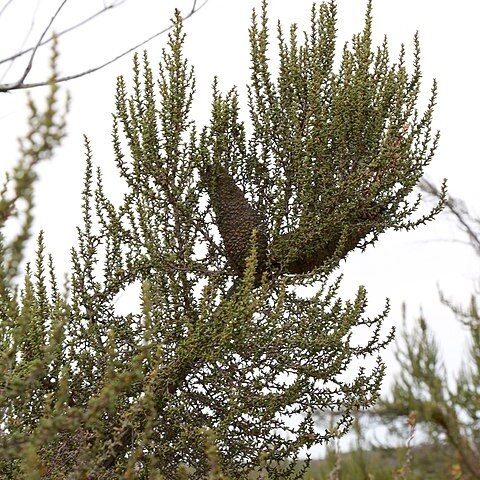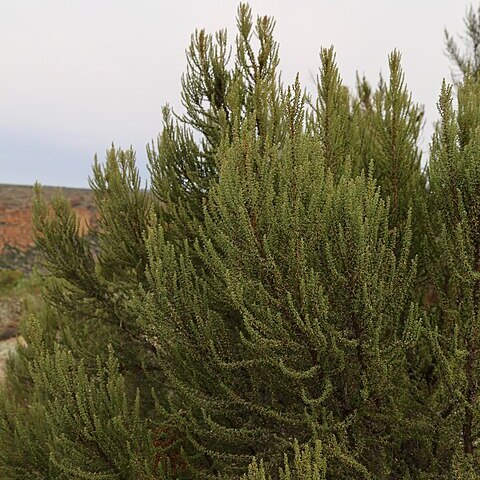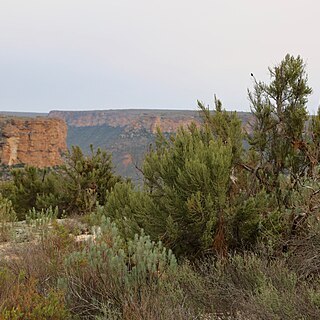Trees up to 5 m tall with main trunks butressed, up to 500 mm diam.; bark reddish brown, flaking; branching pattern dichotomous, resulting in a spreading canopy. Branches incano-floccose, glabrescent with age and appearing segmented with leaf sheath residues from obsolete primary leaves. Primary leaves unifoliolate, stipulate, caducous except at swollen branch tips which become female cone-like inflorescences; stipules lanceolate, up to 0.5 mm long, pungent, greyish brown, glabrescent; leaflets lanceolate, (10-)12(-15) mm long, pungent, glabrescent, margins revolute. Secondary leaves unifoliolate, exstipulate; vagina membranous, sheathing, successive vaginas imbricate; leaflets ligulate, (1.5-)3.0(-3.3) x 0.9 mm, up to 0.5 mm thick; margins revolute; upper surface glabrous greyish green, longitudinally grooved, undersurface incano-floccose except for revolute margins and distally raised main vein; apex mucronate, mucro minute, translucent. Male inflorescence: a condensed raceme of 2 or 3, (rarely only 1) flowers on a villous, highly condensed brachyblast in axil of a secondary leaf subapically on a brachyblast on lower part of a main branch bearing a female inflorescence apically. Male flowers: very shortly pedicellate, creamy white; bract narrowly triangular, up to 0.5 mm long, long ciliate, whitish; sepals 4, broadly elliptical to broadly obovate, 1.5-2.0 x 1.2-1.8 mm, apex subacute, thickened, dorsally villous; stamens 4; filaments filiform, up to 2 mm long, glabrous; anthers up to 0.75 x 0.6 mm. Female inflorescence: many condensed double racemes (homothetic dibotrya) each comprising a few, sessile, capitulum-like co-florescences (botrya), aggregated spirally on condensed main axis of an oblong, cone-like polytelic synflorescence apically on a main branch, one of a pair originating from below a cone of previous season; flowering cones (30-)35-40 x (15-)20-25 mm with apical proliferation of main axis (30-)40-50(-60) mm long, secondary cone leaves greenish white incanous, interspersed with long maroon styles; fruiting cones (40-)45-55 x (18-)22-25 mm with apical proliferation of main axis plus proliferation shoots of lateral dibotrya, these thin vegetative branches up to 80 mm long and shrouding cone, caducous; leaves of primary cone axis (primary cone leaves) unifoliolate, vagina grossly expanded, woody, flushed with red, interspersed with longitudinal cartilaginous veins and with pungent woody stipules up to 2 mm long, ciliate, vaginas sheathing main cone axis and segregating individual dibotrya, leaflets narrowly elliptical, up to 2.5 x 1 mm woody, pungent to minutely bifid with remnants of short lanate indumentum basally; leaves of secondary cone axis (secondary cone leaves) trifoliolate, arranged involucre-like interspersing florescences (botrya), vagina 3.0-3.5 x 4-5 mm, dorsi-ventrally flattened, woody, longitudinally furrowed, exstipulate, leaflets 3.0-3.5 x 2.0-2.5 mm, greyish green, incano-floccose, conical-mucronate, mucro 1.5-1.75 mm long, pungent, becoming woody, leaflets of each leaf arranged in triangle, reducing in size towards centre of involucre; co-florescence (botryum) 7-12-flowered, highly condensed with axis a flattened platform of irregular shape bearing minute pedicels subtended by reduced and modified bracts interspersed with villous hairs. Female flowers: hidden except for styles and tips of calyx lobes; bract subulate, up to 0.5 mm long, long-ciliate, translucent; pedicel 0.1-0.2 mm long; sepals (3)4, linear-acute, 2.0-2.5 x 0.3-0.5 mm, reflexed, glabrous; receptacle cylindrical, 1.5-1.7 x 0.75 mm, faintly longitudinally furrowed, glabrous; style 1, linear, plano-convex, 5.5-6.0 x 0.2-0.25 mm, acute, spirally twisted, exerted from cone, deep maroon, upper half edged with short irregular teeth. Fruit: irregularly longitudinally angled, 2.3-2.5 x 1.0-1.2 mm, apically concave around style remnant, dark brownish grey and glabrous with two narrow whitish longitudinal wings; retained within cone for several years. The flowering period...between late October and late November.
More
Monoecious or dioecious shrub or tree to 3 m. Primary leaves fugacious, trifoliolate, secondary leaves simple, ± 2 mm long, tongue-shaped, greyish green, grooved adaxially. Flowers: male: minute, borne singly or in small clusters in axils of vegetative leaves, stamens 3; female: hidden in compact cones ± 30 mm long, terminally on branches, styles strap-shaped, red.



